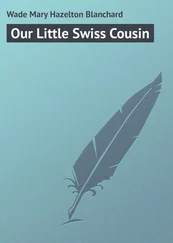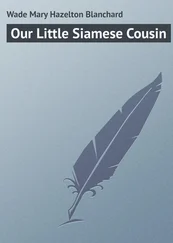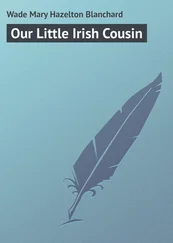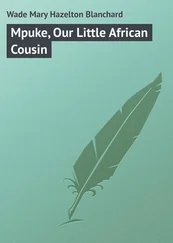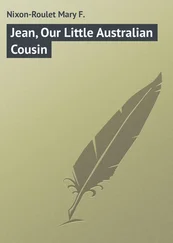Mary Wade - Yellow Thunder, Our Little Indian Cousin
Здесь есть возможность читать онлайн «Mary Wade - Yellow Thunder, Our Little Indian Cousin» — ознакомительный отрывок электронной книги совершенно бесплатно, а после прочтения отрывка купить полную версию. В некоторых случаях можно слушать аудио, скачать через торрент в формате fb2 и присутствует краткое содержание. ISBN: , Жанр: foreign_language, foreign_prose, foreign_children, на английском языке. Описание произведения, (предисловие) а так же отзывы посетителей доступны на портале библиотеки ЛибКат.
- Название:Yellow Thunder, Our Little Indian Cousin
- Автор:
- Жанр:
- Год:неизвестен
- ISBN:http://www.gutenberg.org/ebooks/43251
- Рейтинг книги:3 / 5. Голосов: 1
-
Избранное:Добавить в избранное
- Отзывы:
-
Ваша оценка:
- 60
- 1
- 2
- 3
- 4
- 5
Yellow Thunder, Our Little Indian Cousin: краткое содержание, описание и аннотация
Предлагаем к чтению аннотацию, описание, краткое содержание или предисловие (зависит от того, что написал сам автор книги «Yellow Thunder, Our Little Indian Cousin»). Если вы не нашли необходимую информацию о книге — напишите в комментариях, мы постараемся отыскать её.
Yellow Thunder, Our Little Indian Cousin — читать онлайн ознакомительный отрывок
Ниже представлен текст книги, разбитый по страницам. Система сохранения места последней прочитанной страницы, позволяет с удобством читать онлайн бесплатно книгу «Yellow Thunder, Our Little Indian Cousin», без необходимости каждый раз заново искать на чём Вы остановились. Поставьте закладку, и сможете в любой момент перейти на страницу, на которой закончили чтение.
Интервал:
Закладка:
Mary Hazelton Wade
Yellow Thunder, Our Little Indian Cousin
Once upon a time, as you doubtless know, there were no white people in the Western world. In those days our Indian cousins were free to wander wherever they wished, from the Atlantic to the Pacific.
Some of them had their homes on the great plains, where herds of wild buffaloes supplied them with food and clothing. Others dwelt by the shores of lakes and rivers. Whenever they wished a change, they moved their camps from one spot to another. They had little to fear except the attacks of unfriendly tribes of their own race.
When the white men, with their greater skill and knowledge, came to America, many troubles began for our red cousins. These troubles were such as they had never known before. They were driven away from the homes that were so dear to them. Great numbers were killed. Strong drink, given to them by the white strangers, was the ruin of thousands. Still others died from sickness and want.
The people whom we have called Indians ever since Columbus gave them that name now think with sadness of the old free and happy days before the white traders gave them beads and blankets in exchange for large tracts of land.
There were then no roads, no cities, no stores or factories in all this vast continent, and yet our red cousins were freer and happier than they can ever hope to be again.
Malden, Mass., May, 1904 .
YELLOW THUNDER
Our Little Indian Cousin
They call him Yellow Thunder. Do not be afraid of your little cousin because he bears such a terrible name. It is not his fault, I assure you. His grandmother had a dream the night he was born. She believed the Great Spirit, as the Indians call our Heavenly Father, sent this to her. In the dream she saw the heavens in a great storm. Lightning flashed and she constantly heard the roar of thunder. When she awoke in the morning she said, "My first grandson must be called 'Yellow Thunder.'" And Yellow Thunder became his name.
But his loving mamma does not generally call him this. When he is a good boy and she is pleased with him, she says, "My bird." If he is naughty, for once in a great while this happens, she calls him "bad boy."
For some reason I don't understand myself, she rarely speaks his real name. Perhaps it is sacred to her, since she believes it was directed by the Great Spirit.
Yellow Thunder lives in the forests of your own land, North America. His skin is a dull, smoky red, his eyes are black and very bright, his hair is black and coarse. His body is straight and well formed. He can run through the woods as quickly and softly as a deer. He lives in a bark house made by his mother. His father is strong and well, yet he did not help in building it. He thinks such work is not for men. It is fit only for women.
When I tell you how it is made, you will not think it is very hard work. Yellow Thunder's patient mamma chose the place for her home, and then gathered some long poles in the forest. She set these poles in a circle in the ground, bent them over at the top, and tied them. She left a small hole at the top. The framework of the house was now complete. What should she have for a covering? She went out once more into the woods and got some long sheets of white birch bark. At the end of each sheet she fastened a rim of cedar wood. The sheets of bark were hung on the framework, with the rim at the bottom of each one, and the house was finished. The rim would be useful in keeping the bark from being lifted by the winds. But, if there should be a severe storm, the Indian woman would lay stones on the rims to keep the bark down more firmly still.
This is Yellow Thunder's simple home, summer and winter. You would probably freeze there in the cold days of December, but the Indian boy was brought up to endure a great deal of cold.
Let us look inside. We must first lift the deerskin which hangs in the doorway. Does the family sit on the cold, bare ground, do you think? Oh, no; Yellow Thunder has helped his mamma make good thick rugs out of the bullrushes and flags which they gather every autumn. These rugs are very pretty, for they are woven and dyed with the bright colours the Indian women know how to make. There are many of these mats, because they are used for many purposes. Yellow Thunder sleeps on one of them at night. In the day-time he sits on a mat whenever he is in the house. But he is such a strong lad, he is out-of-doors nearly all the time, both in sunshine and in storm.
In the middle of the house you will notice there is a bare spot covered with clean sand. This is the place where the fire is made. It is carefully swept when there is no fire. If you look directly over the fireplace, you can see the sky. On rainy days, unless the mother is cooking, she keeps the hole covered with a piece of deerskin, that the inside of the house may be dry.
But how does she prepare the food for breakfast, for that is the principal meal of the day to the Indian? A strong hook is fastened in the framework of the house, above the fireplace. The Indian mother hangs a pot on the hook, puts in the meat or fish, and it boils quickly over the burning twigs which her little boy has gathered.
Let us look around the wigwam. Of course, you have long ago heard that name for the Indian's house. What beautiful baskets of rushes those are! I wonder how the red men discovered the way of making such beautiful colours. Besides many other things, the jewelry and clothing of the whole family are kept in these baskets. Look up at the sides of the hut and notice the bows and arrows. And, yes! there is a real tomahawk, with its sharp edge sticking in that corner. Ears of corn braided together are hanging from the framework.
But the prettiest thing we see is the baby's cradle, fastened to a peg. Two bright black eyes are looking out of it, and that is all we can see of Yellow Thunder's baby sister, "Woman of the Mountain." It took the loving mother a long time to make that cradle. She was very happy while doing it, for she loves her baby tenderly.
It is hardly right to call it a cradle. Baby-frame is a better name. It was made in three pieces, out of the wood of the maple-tree, – a straight board about two feet long for the bottom, a carved foot-board, and a bow which is fastened to the sides and arches over the baby's head. These are all bound together with the sinews of a deer. It is lined with moss, and then Woman of the Mountain is fastened in her queer little bed with straps, which her mamma has made beautiful with bead work. Moss is placed between her feet, her hands are bound at her side, her feet are bound down also, and a beaded coverlet is placed over her tiny body. She looks like a little mummy.
If it is stormy she is hung up on a peg in the hut to swing, but if it is a pleasant day, she swings on the branch of a tree and watches the leaves flutter and the birds sing. She is a happy little baby, although you would hardly think it possible. She got used to her imprisonment almost as soon as she was born. She doubtless thinks it is all right.
When mamma goes out into the forest to gather wood, or into the corn field to work, Woman of the Mountain goes too. The baby-frame is fastened on her mother's back by a pretty beaded strap bound over the woman's forehead.
When the Indian baby was only two days old, she was fastened into her cradle and carried all day on mamma's back while she was weeding the garden. To be sure, the woman stopped two or three times to feed her baby, but the little thing was not once taken out of her frame.
Perhaps you would like to hear a lullaby the Indian mamma often sings to her little one as she swings in her frame. I fear you could not understand the Indian words, so I will give them as Mrs. Elizabeth Oakes Smith wrote them in English:
Читать дальшеИнтервал:
Закладка:
Похожие книги на «Yellow Thunder, Our Little Indian Cousin»
Представляем Вашему вниманию похожие книги на «Yellow Thunder, Our Little Indian Cousin» списком для выбора. Мы отобрали схожую по названию и смыслу литературу в надежде предоставить читателям больше вариантов отыскать новые, интересные, ещё непрочитанные произведения.
Обсуждение, отзывы о книге «Yellow Thunder, Our Little Indian Cousin» и просто собственные мнения читателей. Оставьте ваши комментарии, напишите, что Вы думаете о произведении, его смысле или главных героях. Укажите что конкретно понравилось, а что нет, и почему Вы так считаете.


